Search
- Page Path
-
- HOME
- Search
- Review Article
- Need for national guidance regarding proactive care of infants born at 22–23 weeks' gestation
- Ga Won Jeon
-
With recent rapid improvements in neonatal intensive care, the limit of viability has shifted downward to 22–23 weeks' gestation. The younger the gestational age of preterm infants, the higher the risk of survival despite severe neurodevelopmental impairments. For infants born at 22–23 weeks' gestation, the limit of viability, neurodevelopmental outcomes, and survival rates may be determined by the quality of... -
DOI: https://doi.org/10.3345/cep.2024.01277 [Accepted]
- Nephrology (Genitourinary)
- Neonatal hypertension: concerns within and beyond the neonatal intensive care unit
- Kathleen Altemose, Janis M. Dionne
- Clin Exp Pediatr. 2022;65(8):367-376. Published online May 30, 2022
-
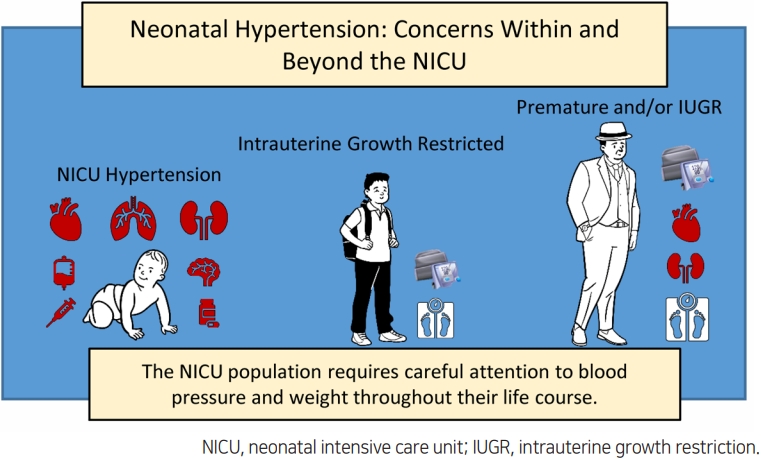
Some neonates, especially those who are premature, may experience hypertension while in the neonatal intensive care unit (NICU). The most common causes are prematurity-related and the hypertension usually resolves over the first 1–2 years of life. Unfortunately, the increasing population of NICU graduates is at risk for later cardiovascular and kidney disease in childhood and adulthood. This population requires careful attention to blood pressure and weight throughout their life course.
- Original Article
- Other
- Risk factors and screening timing for developmental dysplasia of the hip in preterm infants
- Ga Won Jeon, Hye Jung Choo, Yong Uk Kwon
- Clin Exp Pediatr. 2022;65(5):262-268. Published online November 5, 2021
-

Question: When is the best screening timing and what is the risk factor for developmental dysplasia of the hip (DDH) in preterm infants?
Finding: Ultrasonography performed earlier than 38 weeks of postmenstrual age caused unnecessary subsequent ultrasonography. DDH did not occur predominantly on the left side or in breech infants.
Meaning: The screening timing, etiology, and risk factors for DDH in preterm infants are somewhat different from those in term infants.
- Review Article
- Neonatology (Perinatology)
- Pathophysiology, classification, and complications of common asymptomatic thrombocytosis in newborn infants
- Ga Won Jeon
- Clin Exp Pediatr. 2022;65(4):182-187. Published online October 18, 2021
-
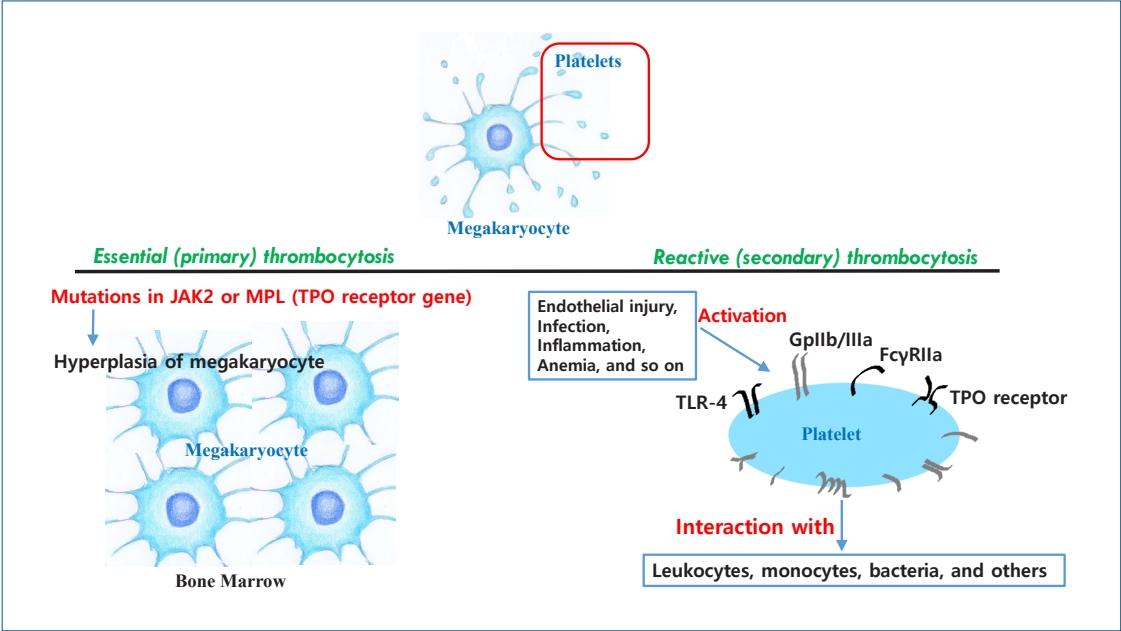
· Thrombocytosis, common in newborns and infants (<2 years) (3%–13%), is caused by elevated thrombopoietin (TPO) concentrations.
· Serum TPO levels are significantly higher immediately to 1 month postnatal and decrease with age.
· Platelet counts are positively correlated with gestational age at birth and postnatal age.
· Thrombocytosis is more common in preterm than in term infants.
· Thrombocytosis in newborns is reactive and resolves spontaneously without complications.
- Original Article
- Neonatology (Perinatology)
- Effect of red blood cell transfusion on short-term outcomes in very low birth weight infants
- Eui Young Lee, Sung Shin Kim, Ga Young Park, Sun Hyang Lee
- Clin Exp Pediatr. 2020;63(2):56-62. Published online February 6, 2020
-
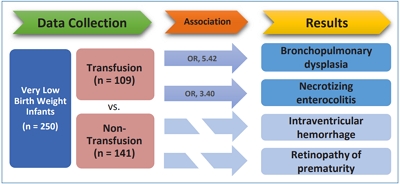
Question: Does RBC transfusion affect the short-term outcomes of VLBW infants?
Finding: The results showed that RBC transfusion was significantly related to the incidence of BPD (OR, 5.42; P<0.001) and NEC (OR, 3.40; P=0.009).
Meaning: Careful consideration of the patient’s clinical condition and appropriate guidelines is required before administering RBC transfusions.
- Review Article
- Neonatology (Perinatology)
- Short- and long-term outcomes of very low birth weight infants in Korea: Korean Neonatal Network update in 2019
- Jang Hoon Lee, YoungAh Youn, Yun Sil Chang; Korean Neonatal Network
- Clin Exp Pediatr. 2020;63(8):284-290. Published online February 5, 2020
-

The Korean Neonatal Network (KNN) has collected population-based data for very low birth weight infants (VLBWIs) born in Korea since 2013. The survival rate of all VLBWIs was 86% in Korea. The overall prevalence of cerebral palsy was 6.2%–6.6%. Bilateral blindness and hearing loss were reported in 0.2%–0.3%, 0.8%–1.9%, respectively. The KNN has published annual reports and papers for facilitating the improvement of VLBWIs outcome in Korea.
- Bronchopulmonary dysplasia: how can we improve its outcomes?
- Tae-Jung Sung
- Clin Exp Pediatr. 2019;62(10):367-373. Published online May 17, 2019
-

Bronchopulmonary dysplasia (BPD) is a chronic lung disease of preterm infants with multiple factors affected from prenatal to postnatal periods. Despite significant advances in neonatal care over almost 50 years, BPD rates have not decreased; in fact, they may have even increased. Since more preterm infants, even at periviable gestational age, survive today, different stages of lung development affect the...
- Practice for preterm patent ductus arteriosus; focusing on the hemodynamic significance and the impact on the neonatal outcomes
- Jin A Lee
- Clin Exp Pediatr. 2019;62(7):245-251. Published online April 8, 2019
-
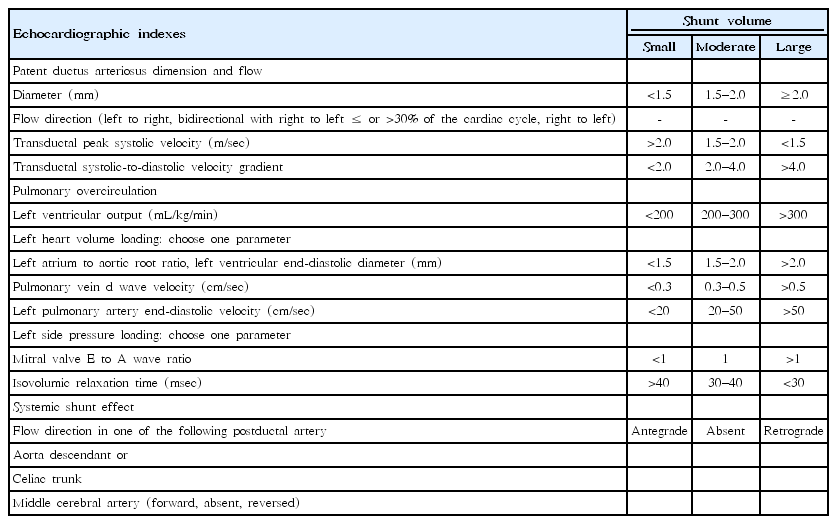
Hemodynamically significant preterm patent ductus arteriosus (PDA) affects mortality; comorbidities such as necrotizing enterocolitis, intraventricular hemorrhage, and bronchopulmonary dysplasia; and adverse long-term neurodevelopmental outcomes in preterm infants, particularly in very low birth weight infants. However, recent studies have indicated that there is no consensus on the causal relationship between PDA and neonatal outcomes, the benefit of PDA treatment, the factors...
- Original Article
- Neonatology (Perinatology)
- Transient intubation for surfactant administration in the treatment of respiratory distress syndrome in extremely premature infants
- Ji Won Koh, Jong-Wan Kim, Young Pyo Chang
- Clin Exp Pediatr. 2018;61(10):315-321. Published online September 16, 2018
-
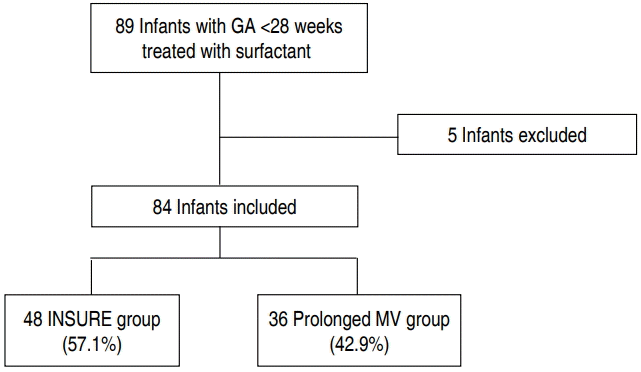
Purpose: To investigate the effectiveness of transient intubation for surfactant administration and extubated to nasal continuous positive pressure (INSURE) for treatment of respiratory distress syndrome (RDS) and to identify the factors associated with INSURE failure in extremely premature infants. Methods: Eighty-four infants with gestational age less than 28 weeks treated with surfactant administration for RDS for 8 years were included. Perinatal...
- Postdischarge growth assessment in very low birth weight infants
- Joon-Sik Park, Jungho Han, Jeong Eun Shin, Soon Min Lee, Ho Seon Eun, Min-Soo Park, Kook-In Park, Ran Namgung
- Clin Exp Pediatr. 2017;60(3):64-69. Published online March 27, 2017
-
Purpose The goal of nutritional support for very-low-birth-weight (VLBW) infants from birth to term is to match the
in utero growth rates; however, this is rarely achieved.Methods We evaluated postdischarge growth patterns and growth failure in 81 Korean VLBW infants through a retrospective study. Weight and height were measured and calculated based on age percentile distribution every 3 months until age 24...
- Cardiology
- Correlation of B-type natriuretic peptide levels and echocardiographic parameters in preterm infants with patent ductus arteriosus
- Hyun Ah Jeong, Jeonghee Shin, Eunji Kim, Eun Hee Lee, Byung Min Choi, Chang Sung Son, Joo Won Lee
- Clin Exp Pediatr. 2016;59(4):183-189. Published online April 30, 2016
-
Purpose This study aimed to evaluate the correlation, according to postnatal age, between plasma B-type natriuretic peptide (BNP) levels and echocardiographic parameters for the assessment of patent ductus arteriosus (PDA) in preterm infants with respiratory distress.
Methods We enrolled 42 preterm infants with respiratory distress who underwent serial echocardiographic evaluation with simultaneous plasma BNP measurements until ductal closure. The correlations between BNP levels...
- Severe vitamin D deficiency in preterm infants: maternal and neonatal clinical features
- Sook-Hyun Park, Gi-Min Lee, Jung-Eun Moon, Heng-Mi Kim
- Clin Exp Pediatr. 2015;58(11):427-433. Published online November 22, 2015
-
Purpose We investigated the vitamin D status of preterm infants to determine the incidence of vitamin D deficiency.
Methods A total of 278 preterm infants delivered at Kyungpook National University Hospital between January 2013 and May 2015 were enrolled. The serum concentrations of calcium, phosphorous, alkaline phosphatase, and 25-hydroxyvitamin D (25-OHD) were measured at birth. We collected maternal and neonatal data such as...
- Low levels of tissue inhibitor of metalloproteinase-2 at birth may be associated with subsequent development of bronchopulmonary dysplasia in preterm infants
- Choae Lee, Jaewoo An, Ji Hee Kim, Eun Sun Kim, Soo Hyun Kim, Yeon Kyung Cho, Dong Hyun Cha, Man Yong Han, Kyu Hyung Lee, Youn Ho Sheen
- Clin Exp Pediatr. 2015;58(11):415-420. Published online November 22, 2015
-
Purpose Bronchopulmonary dysplasia (BPD) is characterized by inflammation with proteolytic damage to the lung extracellular matrix. The results from previous studies are inconsistent regarding the role of proteinases and antiproteinases in the development of BPD. The aim of the present study was to investigate whether matrix metalloproteinase (MMP)-8, MMP-9, tissue inhibitor of metalloproteinase (TIMP)-2, and TIMP-1 levels in the serum of...
- The efficacy and safety of Montelukast sodium in the prevention of bronchopulmonary dysplasia
- Sang Bum Kim, Jang Hoon Lee, Juyoung Lee, Seung Han Shin, Ho Sun Eun, Soon Min Lee, Jin A Sohn, Han Suk Kim, Byung Min Choi, Min Soo Park, Kook In Park, Ran Namgung, Moon Sung Park
- Clin Exp Pediatr. 2015;58(9):347-353. Published online September 21, 2015
-
Purpose The purpose of this study was to evaluate the efficacy and safety of Montelukast sodium in the prevention of bronchopulmonarydysplasia (BPD).
Methods The Interventional study was designed as a multicenter, prospective, and randomized trial, with open labeled and parallel-experimental groups, 66 infants were enrolled and allocated to either the case group (n=30) or the control group (n=36) based on gestational age (GA)....
- Thyroid dysfunction in very low birth weight preterm infants
- Ji Hoon Lee, Sung Woo Kim, Ga Won Jeon, Jong Beom Sin
- Clin Exp Pediatr. 2015;58(6):224-229. Published online June 22, 2015
-
Purpose Thyroid dysfunction is common in preterm infants. Congenital hypothyroidism causes neurodevelopmental impairment, which is preventable if properly treated. This study was conducted to describe the characteristics of thyroid dysfunction in very low birth weight infants (VLBWIs), evaluate risk factors of hypothyroidism, and suggest the reassessment of thyroid function with an initially normal thyroid-stimulating hormone (TSH) as part of a newborn...
- Review Article
- Necrotizing enterocolitis in newborns: update in pathophysiology and newly emerging therapeutic strategies
- Young Youn Choi
- Clin Exp Pediatr. 2014;57(12):505-513. Published online December 31, 2014
-
While the survival of extremely premature infants with respiratory distress syndrome has increased due to advanced respiratory care in recent years, necrotizing enterocolitis (NEC) remains the leading cause of neonatal mortality and morbidity. NEC is more prevalent in lower gestational age and lower birth weight groups. It is characterized by various degrees of mucosal or transmural necrosis of the intestine....
- Adrenal and thyroid function in the fetus and preterm infant
- Hye Rim Chung
- Clin Exp Pediatr. 2014;57(10):425-433. Published online October 31, 2014
-
Adrenal and thyroid hormones are essential for the regulation of intrauterine homeostasis, and for the timely differentiation and maturation of fetal organs. These hormones play complex roles during fetal life, and are believed to underlie the cellular communication that coordinates maternal-fetal interactions. They serve to modulate the functional adaptation for extrauterine life during the perinatal period. The pathophysiology of systemic...
- Original Article
- Fecal calprotectin concentration in neonatal necrotizing enterocolitis
- Jung Min Yoon, Ju Yi Park, Kyung Ok Ko, Jae Woo Lim, Eun Jeong Cheon, Hyo Jeong Kim
- Clin Exp Pediatr. 2014;57(8):351-356. Published online August 25, 2014
-
Purpose Among the many factors associated with acute intestinal mucosal infection, numerous studies have proposed the usefulness of fecal calprotectin. The aim of this study was to evaluate the usefulness of fecal calprotectin in the diagnosis of necrotizing enterocolitis (NEC).
Methods We collected 154 stool samples from 16 very low birth weight and premature newborns at the Konyang University Hospital neonatal intensive care...
- Review Article
- Mesenchymal stem cells transplantation for neuroprotection in preterm infants with severe intraventricular hemorrhage
- So Yoon Ahn, Yun Sil Chang, Won Soon Park
- Clin Exp Pediatr. 2014;57(6):251-256. Published online June 30, 2014
-
Severe intraventricular hemorrhaging (IVH) in premature infants and subsequent posthemorrhagic hydrocephalus (PHH) causes significant mortality and life-long neurological complications, including seizures, cerebral palsy, and developmental retardation. However, there are currently no effective therapies for neonatal IVH. The pathogenesis of PHH has been mainly explained by inflammation within the subarachnoid spaces due to the hemolysis of extravasated blood after IVH. Obliterative...
- Original Article
- The relationship between eosinophilia and bronchopulmonary dysplasia in premature infants at less than 34 weeks' gestation
- Joo Yun Yang, Jihei Cha, So-Yeon Shim, Su Jin Cho, Eun Ae Park
- Clin Exp Pediatr. 2014;57(4):171-177. Published online April 30, 2014
-
Purpose Eosinophilia is common in premature infants, and its incidence increases with a shorter gestation period. We investigated the clinical significance of eosinophilia in premature infants born at <34 weeks gestation.
Methods We analyzed the medical records of premature infants born at <34 weeks gestation who were admitted to the neonatal intensive care unit at Ewha Womans University Mokdong Hospital between January 2003...
- Review Article
- Oxidative stress and the antioxidant enzyme system in the developing brain
- So-Yeon Shim, Han-Suk Kim
- Clin Exp Pediatr. 2013;56(3):107-111. Published online March 18, 2013
-
Preterm infants are vulnerable to the oxidative stress due to the production of large amounts of free radicals, antioxidant system insufficiency, and immature oligodendroglial cells. Reactive oxygen species (ROS) play a pivotal role in the development of periventricular leukomalacia. The three most common ROS are superoxide (O2•-), hydroxyl radical (OH•), and hydrogen peroxide (H2O2). Under normal physiological conditions, a balance...
- Original Article
- Parental concerns about their premature infants' health after discharge from the neonatal intensive care unit: a questionnaire survey for anticipated guidance in a neonatal follow-up clinic
- Ji-Yun Cho, Juyoung Lee, Young Ah Youn, Soon Ju Kim, So Young Kim, In Kyung Sung
- Clin Exp Pediatr. 2012;55(8):272-279. Published online August 23, 2012
-
Purpose The aim of this study was to develop an appropriate nursing information guideline according to corrected age, after investigating parents' concerns about the growth, development, and diseases of their premature infants after discharge from the neonatal intensive care unit (NICU).
Methods The parents of premature infants (birth weight, <2,500 g; gestational age, <37 weeks) who went to a neonatal follow-up clinic after...
- Case Report
- PHACE association with intracranial, oropharyngeal hemangiomas, and an atypical patent ductus arteriosus arising from the tortuous left subclavian artery in a premature infant
- Do-Hyun Kim, Jang Hwan Choi, Jung Ha Lee, Hee Sup Kim
- Clin Exp Pediatr. 2012;55(1):29-33. Published online January 31, 2012
-
PHACE association is a rare neurocutaneous condition in which facial hemangiomas associate with a spectrum of posterior fossa malformations, arterial cerebrovascular anomalies, cardiovascular anomalies, and eye anomalies. We reported a case of PHACE association in a premature infant showing facial, intracranial, and oropharyngeal hemangiomas with evidence of the Dandy-Walker variant and complicated cardiovascular anomalies, including a right-sided aortic arch and...
- Review Article
- Optimal oxygen saturation in premature infants
- Meayoung Chang
- Clin Exp Pediatr. 2011;54(9):359-362. Published online September 30, 2011
-
There is a delicate balance between too little and too much supplemental oxygen exposure in premature infants. Since underuse and overuse of supplemental oxygen can harm premature infants, oxygen saturation levels must be monitored and kept at less than 95% to prevent reactive oxygen species-related diseases, such as retinopathy of prematurity and bronchopulmonary dysplasia. At the same time, desaturation below...
- Original Article
- A study on the measurement of the nucleated red blood cell (nRBC) count based on birth weight and its correlation with perinatal prognosis in infants with very low birth weights
- Tae Hwan Kil, Ji Yeon Han, Jun Bum Kim, Gyeong Ok Ko, Young Hyeok Lee, Kil Young Kim, Jae Woo Lim
- Clin Exp Pediatr. 2011;54(2):69-78. Published online February 28, 2011
-
Purpose The aim of this study was conducted to investigate the mean nRBC count in very low births weight infants (VLBWIs) and to determine the usefulness of the nRBC as an independent prognostic factors of perinatal complications in VLBWIs.
Methods This study was conducted on 112 VLBWIs who were hospitalized in the neonatal intensive care unit (NICU) of the author's hospital within the...
- Review Article
- Changes in birth rates of low birth weight and premature infants in Korea over the past 7 years
- Min Hee Kim
- Clin Exp Pediatr. 2008;51(3):233-236. Published online March 15, 2008
-
In recent years, Korea has experienced a steadily declining birth rate, which is a serious social problem in the country. Although living conditions have improved, the birth rates for low birth weight infants and preterm babies has increased because more and more women choose to give birth later in life and the social environment has changed. The rise in low... -
- Original Article
- Factors influencing birth weight premature infants
- Ji A Aum, Hee Jin Jung, Jae Won Huh, Su Young Hong
- Clin Exp Pediatr. 2007;50(10):954-958. Published online October 15, 2007
-
Purpose : The purpose of this study was to identify factors influencing premature infants who are small for their gestational ago. Methods : The medical records of 1,010 premature infants of 26 to 35 weeks of gestational age born at Il-Sin Christian Hospital, Busan from January 2000 to August 2006 were reviewed. We collected data on gestational age, birth weight, infant... -
- High Frequency Oscillatory Ventilation with Inhaled Nitric Oxide Combined Therapy in The Intractable Respiratory Failure Neonates
- Mi Hyun Lee, Ji Eun Han, Sang Geel Lee
- Clin Exp Pediatr. 2004;47(11):1167-1172. Published online November 15, 2004
-
Purpose : Inhaled nitric oxide(iNO) has been known to improve oxgenation in newborns with persistent pulmonary hypertension(PPHN), but it's not clear that iNo treatment is effective in cases of acute, hypoxic respiratory failure and premature infants. In our study, high frequency oscillatory ventilation(HFV) with iNO combined therapy was tried in intractable respiratory failure neonates who showed no response to conventional... -
- A Clinical Study of Sepsis with Thrombocytopenia in Premature Infants
- Jae Hoon Sim, So Ick Jang, Yun Jung Sim, Do Jun Cho, Dug Ha Kim, Ki Sik Min, Ki Yang Yoo
- Clin Exp Pediatr. 2004;47(10):1058-1064. Published online October 15, 2004
-
Purpose : This study was performed to characterize sepsis with thrombocytopenia in premature infants to determine if thrombocytopenia is a prognostic factor in sepsis in premature infants. Methods : We retrospectively analyzed the medical records of sepsis in premature infants admitted to the neonatal intensive care unit(N=41) at the Hallym University Sacred Heart Hospital from January 1999 to December 2002. The... -
- Antithrombin III in the Diagnosis and Treatment of Disseminated Intravascular Coagulation in Premature Infants
- Su Jin Cho, Hye Ryung Choi, Young Mi Hong, Kyung Hee Kim, Keun Lee, Eun Ae Park
- Clin Exp Pediatr. 2004;47(7):740-745. Published online July 15, 2004
-
Purpose : We evaluated the diagnostic implications and therapeutic efficacy of antithrombin III(AT III) in the disseminated intravascular coagulation(DIC) of premature infants. Methods : Ninety-two premature infants diagnosed with DIC and treated with AT III from March, 2000 to May, 2003 were retrospectively reviewed. Clinical manifestations, complete blood counts, coagulation tests, and AT III levels were compared between the two groups... -
-

-
-
Impact Factor3.2
-
8.02023CiteScore94th percentilePowered by
-









